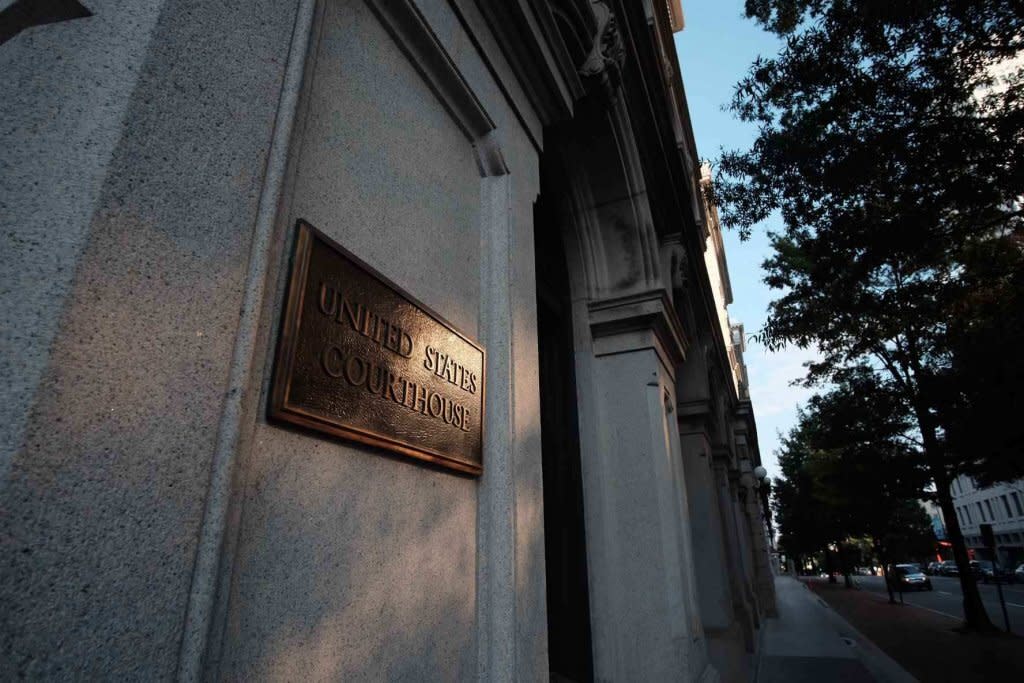Appeals court upholds convictions of three in brutal MS-13 slaying in Prince George’s

The 4th U.S. Circuit Court of Appeals in Richmond, Virginia. (Photo by Ned Oliver/Virginia Mercury)
A federal appeals court upheld the murder and racketeering convictions of three members of the international gang MS-13 for their role in the brutal 2019 killing of a 16-year-old in Prince George’s County.
A three-judge panel of the 4th U.S. Circuit Court of Appeals rejected claims by Jose Domingo Ordonez-Zometa, Jose Henry Hernandez-Garcia and Jose Rafael Ortega-Ayala that evidence against them was improperly obtained by police and should have been suppressed. The court’s Tuesday ruling also rejected Hernandez-Garcia’s claim that he should have been granted a new trial.
The three men were convicted after an eight-day jury trial in U.S. District Court for Maryland, and each given life sentences in 2023.
Two of the defense attorneys could not be reached for comment Friday, while a third declined comment. Attorneys for the government also could not be reached for comment.
Court document say the case began on the night of March 8, 2019, when Ordonez-Zometa, the leader of “Los Ghettos Criminales Salvatruchas,” a branch of MS-13 in Maryland, summoned several members of the “clique” to his home in Hyattsville. He suspected that two gang members, both juveniles, were cooperating with police — something punishable only by death, under the gang’s rules.
When they arrived, Ordonez-Zometa began interrogating the two members on whether they had cooperated with law enforcement, which they denied.
“In fact, neither of the youths had cooperated with law enforcement,” Circuit Judge Robert B. King wrote for the court. “Instead, both had recent and brief interactions with police after running away from their homes.”
But convinced that one of the two had talked to police, and after speaking by phone with a senior MS-13 member in El Salvador, Ordonez-Zometa began to assault the 16-year-old, identified in court documents only as “John Doe,” beating him and cutting his face.
SUBSCRIBE: GET THE MORNING HEADLINES DELIVERED TO YOUR INBOX
Eventually, Ordonez-Zometa had the teen brought to the basement, where he ordered Hernandez-Garcia, Ortega-Ayala and other gang members not named in the case to use “the glove” — a three-bladed weapon that can be affixed to the hand — to attack the teen while another gang member filmed on his cell phone. Each gang member took part in what King called the “brutal and horrific” attack.
The teen suffered 144 wounds and “died from those injuries in Ordonez-Zometa’s basement, at just 16 years of age,” King wrote.
Ordonez-Zometa directed Hernandez-Garcia and another gang member to clean the murder scene and dispose of blood-stained carpeting. The teen’s body was shoved in the trunk of Ordonez-Zometa’s wife’s Nissan Altima, which Ortega-Ayala and two others drove to Stafford County, Virginia, where they dumped the body and set it alight using gasoline.
When a Stafford County Sheriff’s deputy discovered the burning remains, the body was unidentifiable. But police were able to circulate a photo of a tattoo on the teen’s body that the boy’s mother identified as her son’s. She gave police the names of others who were with her son before his death, which eventually led to the three defendants.
By March 13, Stafford County officials had provided Prince George’s County police with a photo of Ordonez-Zometa and advised them to be on the lookout for a gold Nissan with a black hood. When police saw Ordonez-Zometa come out of his Hyattsville house and get into the Nissan, they pulled it over for failing to signal a turn, then arrested him.
Ordonez-Zometa argued at trial that police did not have probable cause to stop the Nissan. But U.S. District Judge Paula Xinis disagreed and allowed the evidence, and the appeals court upheld that decision Tuesday.
Officers “watched a man who matched the photograph of Ordonez-Zometa leave a residence suspected to be the murder scene, get into a car matching the description of one tied to the Doe murder, and drive away,” King wrote. “That was certainly enough to justify the traffic stop.”
Even though he waived his Miranda rights, Ordonez-Zometa also argued that statements he made during his initial interrogation were involuntary, and given due to “coercive interrogation tactics.” He said he was worried about family members, who were in the car with him but being held in a separate room, and about a detective’s statement that his silence could be used against him in court.
The trial court called the detective’s statement “unfortunate and plainly incorrect.” But the courts found that none of those factors “overbore” the defendant’s will to make a statement, which was thus voluntary and admissible.
“Neither uncomfortable circumstances nor a misstep by law enforcement will render a statement involuntary,” King wrote. Even if it was, he said, the weight of other evidence presented by the state would have been enough to convict Ordonez-Zometa without his statements.
“Two former gang members confirmed that he ordered the killing of John Doe, arranged its logistics, directed others to dispose of Doe’s body, and oversaw the cleanup,” King wrote. “Moreover, forensic evidence from the Nissan vehicle corroborated key aspects of those witnesses’ accounts. The trial evidence thus provided the jury with ample grounds for conviction, entirely apart from the contested statements.”
Ortega-Ayala argued that search warrants for his Facebook account, home and cell phone were overly broad, but the appellate judges said the warrants were “particularized and specific.”
As for Hernandez-Garcia’s appeal of Xinis’ decision to deny him a new trial, King wrote that there was no “serious miscarriage of justice” that would merit a new trial.


